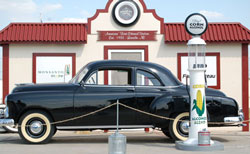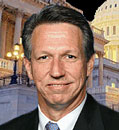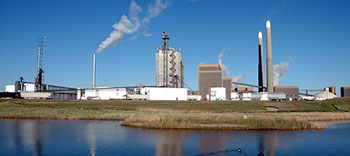 A hydrogen-powered Ford Fusion has taken part in the annual Speed Week at the famous Bonneville Salt Flats this week and hit an amazing 161 MPH!
A hydrogen-powered Ford Fusion has taken part in the annual Speed Week at the famous Bonneville Salt Flats this week and hit an amazing 161 MPH!
This article from the Journal and Courier (Lafayette and West Lafayette, Indiana) says the Ford Fusion 999, a hydrogen- and electric- powered car designed and built in cooperation between Ford and Ohio State University, blazed across the salt flats… and Matt Zuehlk, the project leader for Ford’s 999 says they want to hit 200 MPH:
By doing so, he said, the car will help change the perception that alternative-fuel cars lack muscle and grit. If it happens, company brass can thank the budding designers and engineers at OSU. They turned to Ford because the students’ electric-only cars had hit a ceiling at Bonneville.
The students figured adding hydrogen fuel cells might allow for more speed. Ford decided not only to help add hydrogen power to the Buckeye Bullet – a streamlined dragster – but also to model a potentially realistic version based on the Fusion.
On Monday, having qualified with the 161-mph run, the team returned to the track to make its first run at 200 mph. But before (driver Rick) Byrnes got even a mile, a hydrogen sensor shut down the engine.
“They have multiple safety features,” Byrnes said, “mostly for me.”
The car’s electric motor is fed by a fuel cell that generates electricity by combining oxygen and hydrogen. The technology is not new, but harnessing enough power to push that technology so fast is.
The latest breakdown was actually an aerodynamic design problem, but officials believe they proved that hydrogen can be a hot fuel for a cool car.


 A new tradition at the 150-year-old Indiana State Fair has started this year as biodiesel powers the fair’s midway.
A new tradition at the 150-year-old Indiana State Fair has started this year as biodiesel powers the fair’s midway. The Research Institute of Innovative Technology for the Earth is aiming for commercial production in three years. RITE was established in 1990 by the government and leading Japanese firms in such industries as automobiles and power.
The Research Institute of Innovative Technology for the Earth is aiming for commercial production in three years. RITE was established in 1990 by the government and leading Japanese firms in such industries as automobiles and power. Fairgoers have the opportunity to reminisce about the customer service of old-time filling stations at the 2007 Missouri State Fair. Tad Whitten, owner of Motorsports Management, is displaying his replica of a 1933 Ethanol filling station at the fair. But, the exhibit is more than just a display. The old-fashioned filling station features skits throughout the day that are meant to help educate fairgoers on the history of ethanol. Tad says most people are surprised to find out that ethanol has been around as a fuel source for more than 100 years. You can listen to my conversation with Tad here:
Fairgoers have the opportunity to reminisce about the customer service of old-time filling stations at the 2007 Missouri State Fair. Tad Whitten, owner of Motorsports Management, is displaying his replica of a 1933 Ethanol filling station at the fair. But, the exhibit is more than just a display. The old-fashioned filling station features skits throughout the day that are meant to help educate fairgoers on the history of ethanol. Tad says most people are surprised to find out that ethanol has been around as a fuel source for more than 100 years. You can listen to my conversation with Tad here: European mega-financier, Fortis, has inked a deal to buy 1.1 million megawatt hours of power for the next 10 years from Enel North America. The estimated $80-million deal is seen as a hedge against the price of electricity from natural gas.
European mega-financier, Fortis, has inked a deal to buy 1.1 million megawatt hours of power for the next 10 years from Enel North America. The estimated $80-million deal is seen as a hedge against the price of electricity from natural gas. A biodiesel plant that will add 30 percent to the U.S. biodiesel production capacity when it opens will start doing just that when the Imperium Renewables plant at Gray’s Harbor in Washington state starts production on Wednesday.
A biodiesel plant that will add 30 percent to the U.S. biodiesel production capacity when it opens will start doing just that when the Imperium Renewables plant at Gray’s Harbor in Washington state starts production on Wednesday. Congressman Tim Mahoney is the honorary summit chair and the
Congressman Tim Mahoney is the honorary summit chair and the 
 Unique to the U.S. ethanol industry, Blue Flint Ethanol is located adjacent to Coal Creek Station, a coal-fired electric facility, and is using the excess steam from Coal Creek to run its ethanol production operations.
Unique to the U.S. ethanol industry, Blue Flint Ethanol is located adjacent to Coal Creek Station, a coal-fired electric facility, and is using the excess steam from Coal Creek to run its ethanol production operations.
 “SunEthanol has unique technology that if proven to be commercially feasible will be a positive step forward for cellulosic ethanol.” said Bill Honnef, VeraSun Senior Vice President, Sales and Marketing. “While we believe corn-based ethanol production will continue to play a key role in our industry long into the future, ethanol from cellulosic feedstocks will complement corn-based ethanol in meeting the growing global demand for renewable fuels. We continue to evaluate technologies that have the potential to efficiently convert cellulose to biofuels.”
“SunEthanol has unique technology that if proven to be commercially feasible will be a positive step forward for cellulosic ethanol.” said Bill Honnef, VeraSun Senior Vice President, Sales and Marketing. “While we believe corn-based ethanol production will continue to play a key role in our industry long into the future, ethanol from cellulosic feedstocks will complement corn-based ethanol in meeting the growing global demand for renewable fuels. We continue to evaluate technologies that have the potential to efficiently convert cellulose to biofuels.”